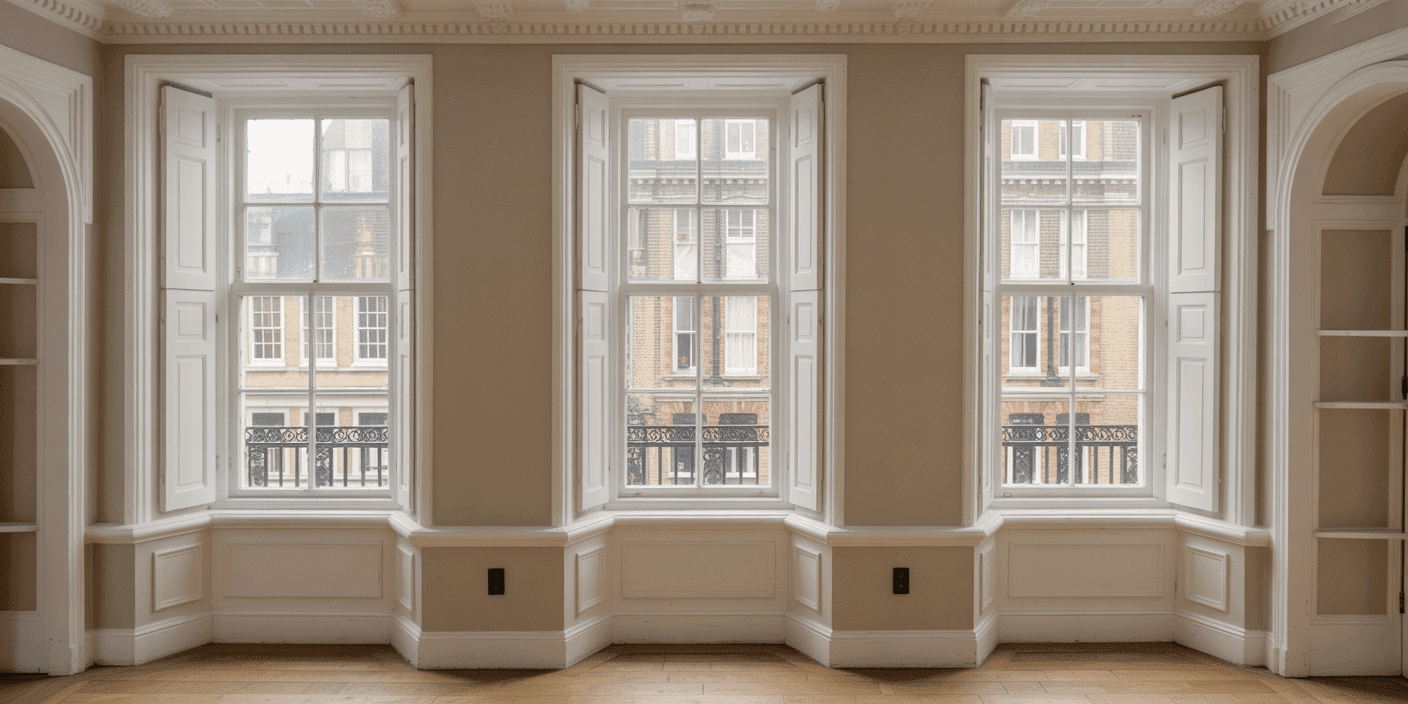The Quiet Villain in Your Living Room
Each winter morning, a silent indicator appears across countless windows in London’s most prestigious homes: a thin film of condensation trailing along the inner pane. You may notice it on the sill. You may feel it in the chill that escapes from the frame’s edge.
In homes of distinction—whether in Kensington, Richmond, or Hampstead—this persistent moisture should not exist. Yet it does. Not because the home is poorly built. Not because it lacks prestige. But because the windows themselves are underperforming in a way that is both subtle and systemic.
Condensation is not a seasonal nuisance.
It is a visible symptom of thermal failure within the frame—a breakdown in insulation where cold air bridges through the structure, lowering the surface temperature and inviting internal moisture to settle.
This phenomenon—known as thermal bridging—means your windows are colder than the room around them. And when the warm, moisture-laden air inside your home makes contact with those cold surfaces, condensation forms.
It is not random. It is not unavoidable.
And it is not acceptable in a well-performing home.
At Sash Windows London, we encounter this pattern regularly in high-value properties across the capital. Externally flawless, architecturally sympathetic, and often recently refurbished—yet quietly compromised by frames that transfer cold rather than contain it.
In these cases, condensation is not the problem.
It is the warning.
A precise indicator that your windows are not performing to modern thermal standards, despite appearing traditional, elegant, and intact.
Understanding this is the first step toward resolving it. The issue lies not with the glass, the weather, or the age of the home—but within the construction of the frame itself. That’s where the solution begins.
What Your Windows Are Really Telling You
Condensation may show up as a streak, a mist, or a pool of water on your sill—but what it’s really doing is signalling a breakdown in thermal control.
It’s a conversation your home is trying to have with you. One that begins and ends with physics.
Let’s simplify it: warm air holds moisture. When that warm, moisture-rich air meets a cold surface—like the interior edge of an underperforming window frame—it cools rapidly. The moisture in the air has nowhere to go, so it condenses into water droplets on the coldest nearby material.
In well-designed homes, that shouldn’t be your window.
But if you’re seeing condensation, it means it is.
At Sash Windows London, we diagnose this situation regularly in homes across the capital. Often, it’s a high-spec home fitted with charming period-style timber frames or cheaper aluminium replacements—chosen for their aesthetics, but never designed to handle modern thermal expectations.
Here’s what your windows are telling you:
- “I’m colder than the rest of your room.”
- “I’m leaking heat, not holding it.”
- “I’m turning your warm air into water.”
This effect is worsened in single-material frames—where there’s no insulation between the inside and outside surfaces of the frame. These act as thermal bridges: invisible highways that allow cold to pass straight through the material, cooling the internal surface to dew point, and triggering that morning fog you now treat as normal.
But it isn’t normal.
It’s a performance failure.
And while it may seem like a nuisance, condensation is really a preview of larger problems: swelling joinery, peeling paint, rotting sills, even internal wall mould. Left unchecked, it turns elegance into expense.
Fortunately, the problem is entirely preventable—with one quiet innovation designed not to be seen, but to be felt.
The Cold Bridge Problem: Why Your Frames Are Working Against You

Every window has two jobs:
- Keep the heat inside your home, and
- Keep the cold firmly outside.
Most look the part. Few do the work.
If you’re seeing condensation, it’s because your frames are acting as a conductor, not a barrier—quietly moving cold from the outside straight through the material to the inside surface. This is what builders and engineers call a thermal bridge. Sash Windows London sees it every week in homes that, on the surface, appear perfectly insulated.
Here’s what’s happening behind the scenes:
The moment cold meets your frame, your comfort is compromised
Materials like standard aluminium or uninsulated timber can become extremely cold, especially on winter mornings. The inside surface cools down so much that your indoor air condenses on contact. That’s why the glass fogs along the edges and the paint beneath the sill begins to blister long before you notice anything wrong.
One weak link affects the entire room
A thermal bridge doesn’t just cause condensation. It undermines the invisible equilibrium of your home. Your heating system works harder. Your energy bills creep up. Those chilly pockets near the windows never quite disappear.
And no matter how luxurious the home, how recently refurbished the interior, or how heavy the curtains, the problem persists until the thermal bridge is removed.
London’s period homes are especially vulnerable
Many Georgian, Victorian, and Edwardian properties were never designed for modern insulation standards. When homeowners upgrade, they often focus on aesthetics—slim sightlines, heritage details, preserving original proportions. But without thermal protection inside the frame, cold effortlessly travels through.
Sash Windows London frequently encounters this scenario:
Beautifully restored sash windows—installed only a few years ago—already showing signs of condensation, drafts, and frame degradation because the manufacturer omitted one essential component.
A component that doesn’t change the look, the sightlines, or the heritage character.
But transforms the window’s performance overnight.
Why Heritage Windows Are the Worst Offenders
Heritage windows are adored for their elegance. Their timeless sightlines, historic detailing, and handcrafted joinery lend character to homes across London—from Georgian terraces in Islington to Victorian villas in Wimbledon. But beneath their beauty often lies a persistent problem: they’re thermally unfit for modern living.
These windows were built in an era before energy efficiency mattered. Before we had central heating. Before the words U-value meant anything to planning authorities.
And while conservation rules rightly preserve the aesthetic, they often result in a trade-off:
Old-world charm at the cost of real-world comfort.
Why are heritage windows prone to condensation?
Because they’re often made from a single material—typically softwood—with no thermal insulation inside the frame. When cold air hits the outer frame, that chill transfers straight through to the inside edge. Moisture in your home, especially from kitchens and bathrooms, then condenses on that cold surface.
And since many heritage properties feature single-glazed panes, slim muntins, and untreated box frames, the problem isn’t just visual—it’s structural. Condensation seeps into joints, saturates sills, and accelerates rot. That gorgeous sash window you paid handsomely to preserve? It’s quietly degrading from the inside out.
Conservation area challenges compound the issue
If you live in a listed building or a conservation zone (which applies to large swathes of London), your options are tightly controlled. Many homeowners believe they can’t upgrade their windows at all. They’re told they must accept draughts, condensation, and sky-high energy bills in exchange for heritage fidelity.
But here’s what most don’t realise: You can have both.
At Sash Windows London, we specialise in crafting heritage-spec windows with built-in thermal breaks—frames that mirror the original detailing, comply with planning requirements, and deliver modern thermal performance that eliminates condensation entirely.
We work with planning officers and conservation consultants to ensure the integrity of your home’s history is preserved—while its thermal envelope is quietly transformed.
The real enemy isn’t planning. It’s poor design.
And the solution isn’t visible.
It’s inside the frame—where thermal breaks create a barrier that stops cold in its tracks, even in windows that look 150 years old.
The Real Cost of Doing Nothing
Most homeowners treat condensation like a nuisance—something you wipe off and forget. But the longer you ignore it, the more expensive it becomes.
Condensation is not just a sign of discomfort. It’s the beginning of frame failure, paint breakdown, mould growth, and long-term energy loss. It seeps into corners, under sills, behind blinds—often unnoticed until the damage is irreversible.
Rot doesn’t happen overnight—but it always starts with moisture
Softwood frames exposed to daily moisture swell and shrink with temperature changes. Over time, this flexing creates microfractures in paint and sealant. Those beautiful Georgian or Victorian sash frames? They begin to absorb water like a sponge.
Before long, you’ll see:
- Peeling paint
- Discolouration
- Mushy sills
- Black spots (mould) in reveals
- Warped timber that sticks or rattles in the wind
At Sash Windows London, we’ve replaced countless sash frames that were less than 10 years old—fitted by well-meaning joiners who never insulated the frame or broke the thermal bridge. The result: premium homes quietly degrading from the windows inward.
Energy loss through the frame is money disappearing every month
Without a thermal break, your heating system works harder. The warm air in your home escapes faster. The frames act as heat sinks. In energy terms, they’re as leaky as a cracked pipe.
We’ve seen luxury homes in Chelsea and Hampstead losing up to 40% of their heat through their windows—even when double-glazed. Why? Because the frame itself was a thermal highway.
By contrast, modern thermally broken frames:
- Reduce heating demand
- Lower U-values dramatically (1.2 W/m²K or below)
- Can save £1,000+ per year in heating costs in detached or semi-detached homes
The knock-on cost to your property’s value is even greater
Buyers are savvier than ever. EPC ratings matter. So do compliance credentials under Part L (thermal efficiency) and future-proofing for 2025 regulation changes. Damp stains, sticking sashes, and visible condensation are now red flags on a home survey.
Doing nothing doesn’t just cost you comfort—it devalues your asset.
But here’s the good news: with the right frame system, you don’t have to choose between architectural integrity and energy performance.
You can protect the beauty of your windows—and build insulation into the structure itself.
The Engineering Behind Invisible Comfort

Great window design should never call attention to itself. It should simply work—silently, seamlessly, season after season. That’s the principle behind every thermally broken frame we design at Sash Windows London.
When you look at our heritage windows, you’ll see traditional craftsmanship:
Slim timber profiles, period-accurate glazing bars, authentic joints, and finishes tailored to Georgian, Victorian, or Edwardian styles.
But hidden inside the frame?
A high-performance, precision-engineered system that fundamentally changes how your home holds heat.
What exactly is a thermal break—and why does it matter?
A thermal break is a layer of insulating material—often a polyamide or composite—placed between the interior and exterior parts of the window frame. It separates the cold-facing outer surface from the warm interior, effectively blocking the direct path that cold typically takes through conventional materials like aluminium or timber.
This break:
- Prevents interior surfaces from becoming cold
- Stops warm indoor air from condensing on the frame
- Dramatically reduces heat loss
- Creates a warm, dry perimeter—even on freezing mornings
It’s not visible. You won’t feel it directly.
But you’ll feel its impact everywhere else in the room.
What goes into a high-performance Sash Windows London frame?
We don’t just insert a thermal break and call it done. Every element is optimised:
- Multi-material construction: We often use a timber-aluminium composite—timber inside for aesthetics and warmth, aluminium outside for weather resistance and strength.
- Warm-edge spacer bars between glazing panes further reduce condensation risk.
- Triple brush seals and compression gaskets around sashes and casements eliminate draughts.
- Low-conductivity joinery techniques ensure thermal continuity throughout the unit.
- Sub-1.2 W/m²K U-values, exceeding current Part L regulations and approaching Passive House standards in some specifications.
And all of this is done while preserving the authentic look and proportion of your original windows—something off-the-shelf replacements simply cannot offer.
Why heritage homes benefit most
Older homes often lack cavity insulation and rely heavily on their windows to retain heat. By upgrading to a thermally broken system, you’re not just solving a condensation problem—you’re retrofitting your entire property’s thermal envelope.
And because Sash Windows London specialises in conservation-grade systems, everything we do is:
- Planning-approval friendly
- Architect-endorsed
- Built to match historic proportions exactly
In short: we build windows that look like they’ve always belonged—but perform like they were designed yesterday.
From Condensation to Clarity: Life After the Upgrade
It starts with a subtle change.
You wake up one morning and notice something’s missing—not added. There’s no mist on the glass. No damp cloths on the sill. No chill biting at your ankles as you walk past the window.
The room feels… still. Warm. Balanced.
That’s the invisible effect of a thermally broken frame.
For many of our clients at Sash Windows London, it’s not about chasing perfection—it’s about reclaiming peace. They’ve spent years living with beautiful homes that underperform in silence. Radiators are constantly humming. Curtains drawn in daylight. Towels kept nearby just to deal with the morning fog.
And then, after one simple upgrade, everything changes.
“It’s the first winter I haven’t touched the thermostat before 10 am.”
We hear that again and again.
From homeowners in Dulwich and Barnes. From clients in conservation zones who never thought they could legally change their windows. From period property owners who were told by builders that condensation was “just part of owning an old house.”
They’ve now got sash windows that:
- Stay dry, even on sub-zero mornings
- Maintain a steady temperature throughout the home
- Look identical to the original frames
- Require less maintenance, fewer repairs, and zero wiping
It’s not just a comfort upgrade—it’s a lifestyle upgrade.
Invisible engineering, visible relief
When you install thermally broken frames, the results aren’t dramatic in a loud way. They’re dramatic in the absence of problems. No more draughts. No more swollen paintwork. No more worried glances at the EPC rating before putting your home on the market.
One client recently told us:
“The condensation used to make me feel like the house was breathing out. Now it just feels still and calm. Like it’s holding its own.”
That’s the feeling we aim to deliver with every project.
And it’s one you can achieve—without compromising heritage, planning rules, or design intent.
Fix the Frame. Transform the Home.
If you’ve made it this far, you already know the truth:
Condensation is not just an inconvenience.
It’s a symptom of outdated frames, thermal inefficiency, and an invisible design flaw robbing your home of the comfort it deserves.
You don’t need thicker curtains.
You don’t need dehumidifiers, trickle vents, or clever draught blockers.
You need to address the frame.
At Sash Windows London, we specialise in precisely that: engineering thermally broken, heritage-accurate window systems that eliminate condensation while preserving the architectural integrity of your home.
These are not standard replacements.
They are crafted, not just fitted. Designed to solve the underlying issue—not just mask the symptoms.
✅ How to know it’s time:
- You wipe your windows most mornings
- Your frames feel cold to the touch
- You see paint peeling, sills swelling, or black mould appearing
- You’re heating more, but feeling less warm
- You live in a conservation zone and feel stuck
Let’s open the window to better performance.
We’re offering a Thermal Frame Assessment—a no-obligation consultation designed to identify cold bridging, compliance gaps, and hidden frame inefficiencies. Whether you live in a listed property, a period townhouse, or a luxury new build with underperforming joinery, we can help.
👉 Book your free Thermal Frame Assessment today
And discover how the smallest change inside your frame can lead to the biggest difference in your home.
No fog. No chill. No compromise.
Just a window that works—beautifully.







